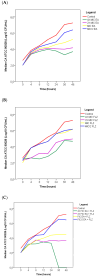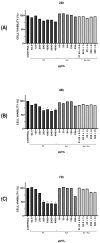Ellagic Acid Potentiates the Inhibitory Effects of Fluconazole Against Candida albicans
- PMID: 39766564
- PMCID: PMC11672414
- DOI: 10.3390/antibiotics13121174
Ellagic Acid Potentiates the Inhibitory Effects of Fluconazole Against Candida albicans
Abstract
Background/Objectives: Antifungal resistance to azoles, coupled with the increasing prevalence of Candida albicans infections, represents a significant public health challenge and has driven the search for new natural compounds that can act as alternatives or adjuvants to the current antifungals. Ellagic acid (EA) has demonstrated antifungal activity; however, its effects are not fully understood. In this study, we investigated the in vitro anti-Candida activity of EA and its ability to potentiate the effects of fluconazole (FLZ) on C. albicans.Methods: The Minimum Inhibitory Concentration (MIC) of EA was determined by broth microdilution and its interaction with FLZ was assessed using a checkerboard assay. Additionally, we examined the effects of EA on yeast-to-hypha transition, inhibition of biofilm formation, time-kill kinetics, hemolytic activity, and cytotoxicity in HeLa ATCC® CCL-2™ cells. Results: EA exhibited MIC values ranging from 250 to 2000 µg/mL and showed synergistic and additive interactions with FLZ, resulting in a marked reduction in the MIC values of FLZ (up to 32-fold) and EA (up to 16-fold). In the time-kill assay, the most effective combinations were 4× EA MIC, 2× EA MIC, and FIC EA + FLZ, which showed fungicidal activity. Furthermore, EA did not show hemolytic activity and demonstrated low and dose-dependent cytotoxicity in HeLa cells, with no cytotoxic effects observed in combination with FLZ. EA and the synergistic combination of EA and FLZ interfered with both the yeast-to-hypha transition process in C. albicans cells and biofilm formation. In addition to its antifungal efficacy, EA demonstrated a favorable safety profile at the concentrations used. Conclusions: This study presents promising results regarding the potential use of EA in combination with FLZ for the treatment of C. albicans infections.
Keywords: anti-Candida activity; antibiofilm activity; ellagic acid; fluconazole.
Conflict of interest statement
The authors declare no conflicts of interest.
Figures







Similar articles
-
[Effect of Huanglian Jiedu decoction in combination with fluconazole on ergosterol of fluconazole-resistant Candida albicans].Zhongguo Zhong Yao Za Zhi. 2015 Feb;40(4):727-32. Zhongguo Zhong Yao Za Zhi. 2015. PMID: 26137698 Chinese.
-
Potential effect of 2-isopropyl-5-methylphenol (thymol) alone and in combination with fluconazole against clinical isolates of Candida albicans, C. glabrata and C. krusei.J Mycol Med. 2018 Jun;28(2):294-299. doi: 10.1016/j.mycmed.2018.04.002. Epub 2018 Apr 14. J Mycol Med. 2018. PMID: 29661606
-
Synergistic Antibiofilm Effects of Pseudolaric Acid A Combined with Fluconazole against Candida albicans via Inhibition of Adhesion and Yeast-To-Hypha Transition.Microbiol Spectr. 2022 Apr 27;10(2):e0147821. doi: 10.1128/spectrum.01478-21. Epub 2022 Mar 17. Microbiol Spectr. 2022. PMID: 35297651 Free PMC article.
-
[Inhibitory effect of diethylstilbestrol on clinical strains of Candida albicans susceptible and resistant to azoles].Rev Iberoam Micol. 2019 Jul-Sep;36(3):115-119. doi: 10.1016/j.riam.2019.03.001. Epub 2019 Jul 9. Rev Iberoam Micol. 2019. PMID: 31300300 Spanish.
-
Combination Effect of Novel Bimetallic Ag-Ni Nanoparticles with Fluconazole against Candida albicans.J Fungi (Basel). 2022 Jul 14;8(7):733. doi: 10.3390/jof8070733. J Fungi (Basel). 2022. PMID: 35887488 Free PMC article.
Cited by
-
Preventive Activity of an Arginine-Based Surfactant on the Formation of Mixed Biofilms of Fluconazole-Resistant Candida albicans and Extended-Spectrum-Beta-Lactamase-Producing Escherichia coli on Central Venous Catheters.Antibiotics (Basel). 2025 Feb 24;14(3):227. doi: 10.3390/antibiotics14030227. Antibiotics (Basel). 2025. PMID: 40149039 Free PMC article.
References
-
- WHO . WHO Fungal Priority Pathogens List to Guide Research, Development and Public Health Action. World Health Organization; Geneva, Switzerland: 2022. p. 33.
-
- Giacobbe D.R., Esteves P., Bruzzi P., Mikulska M., Furfaro E., Mesini A., Tatarelli P., Grignolo S., Viscoli C., Colombo A.L., et al. Initial serum (1,3)-beta-D-glucan as a predictor of mortality in proven Candidaemia: Findings from a retrospective study in two teaching hospitals in Italy and Brazil. Clin. Microbiol. Infect. 2015;21:954.e9–954.e17. doi: 10.1016/j.cmi.2015.06.002. - DOI - PubMed
Grants and funding
- ACT- 05691/21/Fundação de Amparo à Pesquisa e ao Desenvolvimento Científico e Tecnológico do Maranhão
- UNIVERSAL-0965/19/Fundação de Amparo à Pesquisa e ao Desenvolvimento Científico e Tecnológico do Maranhão
- 317186/2023-0 and 305676/2019-9/National Council for Scientific and Technological Development
- Financial code 001/Coordenação de Aperfeicoamento de Pessoal de Nível Superior
LinkOut - more resources
Full Text Sources

